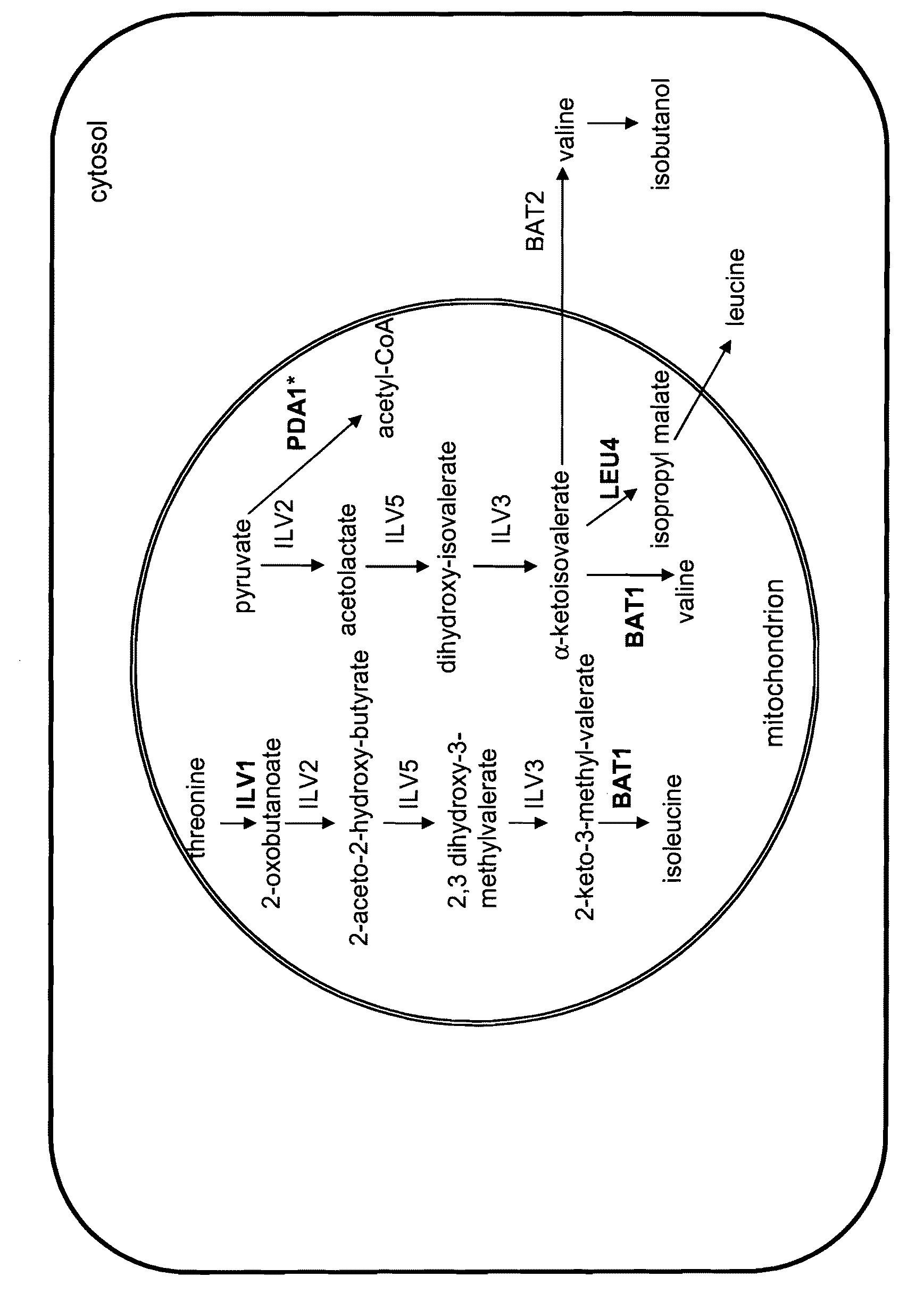Increased production of isobutanol in yeast with reduced mitochondrial amino acid biosynthesis
a technology of mitochondrial amino acid and isobutanol, which is applied in the field of microorganisms, can solve the problems of high yield of fusel oil and/or its components, cost prohibitive use of valine as feedstock, and reduce the activity of endogenous pyruvate decarboxylas
- Summary
- Abstract
- Description
- Claims
- Application Information
AI Technical Summary
Benefits of technology
Problems solved by technology
Method used
Image
Examples
example 1
Eliminating Expression of Enzymes in Branched Chain Amino Acid Biosynthesis Pathways in S. cerevisiae
[0117]Yeast cells were engineered to eliminate activities of specific enzymes of mitochondrial branched chain amino acid biosynthesis. Three chromosomal disruptions were generated in successive fashion in the following genes: ILV1, encoding threonine deaminase; LEU4, encoding 2-isopropylmalate synthase; and BAT1, encoding branched chain amino acid aminotransferase.
[0118]An ilv1::LEU2 cassette was constructed by PCR amplification of the LEU2 marker from pRS425 (ATCC No. 77106) using Phusion DNA polymerase (New England Biolabs Inc., Beverly, Mass.; catalog no. F-540S) with primers 112590-88A (SEQ ID NO:81) and 112590-88B (SEQ ID NO:82). The ILV1 portion of each primer was derived from the 5′ region upstream of the ILV1 promoter and 3′ region downstream of the transcriptional terminator, respectively, such that integration of the LEU2 marker results in replacement of the ILV1 coding re...
example 2
Reduction of Pyruvate Dehydrogenase Activity in S. cerevisiae
[0121]To reduce levels of mitochondrial pyruvate dehydrogenase activity, the native promoter of the PDA1 gene, encoding the E1α subunit of pyruvate dehydrogenase, was replaced with the inducible GAL1 promoter through homologous recombination. The GAL1 promoter and URA3r marker were joined together by SOE PCR. The URA3r marker was PCR amplified from pUC19-URA3r using Phusion DNA polymerase (New England Biolabs Inc., Beverly, Mass.; catalog no. F-540S) and primers 112590-118A (SEQ ID NO:97) and 112590-118B (SEQ ID NO:98). The GAL1 promoter was PCR-amplified from pRS426::GAL1p-alsS (SEQ ID NO:99) using Phusion DNA polymerase (New England Biolabs Inc., Beverly, Mass.; catalog no. F-540S) and primers 112590-118C (SEQ ID NO:100) and 112590-118D (SEQ ID NO:101). pRS426::GAL1p-alsS contained an F1 origin of replication (nt 4976 to 5432) for maintenance in E. coli and a 2 micron origin (nt 2215 to 3560) for replication in yeast. T...
example 3
Isobutanol Production in S. cerevisiae Deletion Strains
[0123]The purpose of this example is to demonstrate isobutanol production in S. cerevisiae in which ILV1 (threonine deaminase) and LEU4 (2-isopropylmalate synthase), and optionally BAT1 (branched-chain amino acid aminotransferase) genes are disrupted. An additional strain has a PDA1 (pyruvate dehydrogenase) disruption.
[0124]Strains BY4741, BY4741 Δilv1 Δleu4, BY4741 Δilv1 Δleu4 Δbat1, and BY4741 Δilv1 Δleu4 Δbat1 GAL1p-PDA1, each transformed with control pR423 (ATCC #77104) and pRS426 plasmids, were grown in synthetic complete media lacking histidine and uracil, and supplemented with 2% glucose under aerobic conditions (20 ml media in 125 ml flask) and cultured at 30° C. with shaking at 220 rpm. Cultures were inoculated at 0.1 OD600 and assayed for isobutanol titers at 24 hours post-inoculation. Isobutanol was quantitated by GC-FID on a HP-Innowax column using a standard curve of pure isobutanol. A standard curve of isobutanol r...
PUM
| Property | Measurement | Unit |
|---|---|---|
| concentration | aaaaa | aaaaa |
| concentration | aaaaa | aaaaa |
| temperature | aaaaa | aaaaa |
Abstract
Description
Claims
Application Information
 Login to View More
Login to View More - R&D
- Intellectual Property
- Life Sciences
- Materials
- Tech Scout
- Unparalleled Data Quality
- Higher Quality Content
- 60% Fewer Hallucinations
Browse by: Latest US Patents, China's latest patents, Technical Efficacy Thesaurus, Application Domain, Technology Topic, Popular Technical Reports.
© 2025 PatSnap. All rights reserved.Legal|Privacy policy|Modern Slavery Act Transparency Statement|Sitemap|About US| Contact US: help@patsnap.com

